U.S. Navy flight Engineer Saw Silver Discs and Entrance to Alleged E.T. and Human Collaboration Base in Antarctica
U. S. Navy Flight Engineer Saw Silver Discs and Entrance
to Alleged E. T. and Human Collaboration Base in Antarctica
© 2015 by Linda Moulton Howe
Copyright © 1999 - 2017 by Linda Moulton Howe.
All Rights Reserved
earthfiles.com
This email address is being protected from spambots. You need JavaScript enabled to view it.
This file is used with permission.
“Talk among the flight crews was that there is a UFO base at South Pole
and some of the crew heard talk from some of the scientists working at the
Pole of EBEs working with and interacting with the scientists
at that air sampling camp/large ice hole.”
- Brian, retired U. S. Navy Flight Engineer
New Reprint On June 30, 2016 January 30, 2015 Albuquerque, New Mexico - On January 2, 2015, I received the email below from a retired U. S. Navy Petty Officer First Class Flight Engineer, who asked me to only call him “Brian.” His high strangeness experiences flying cargo and rescue in Antarctica were in the 1983 to 1997 time period and included several observations of aerial silver discs darting around over the Transantarctic Mountains. He and his crew also saw a big hole in the ice only about five to ten miles from the geographic South Pole (pink circle on map) that was supposed to be a No Fly Zone. But during an emergency medevac situation, they entered the No Fly Zone and saw what they were not supposed to see: an alleged entrance to a human and E. T. science research base created under the ice. Then at a camp near Marie Byrd Land, some dozen scientists disappeared for two weeks and when they re-appeared, Brian's flight crew got the assignment to pick them up. Brian says they would not talk and “their faces looked scared.”
Brian and his flight crew received several orders at different times to not talk and were sternly told that they didn't see what they saw. But he was never asked to sign an official non-disclosure statement. So now that he's retired, he has decided to share what he has seen and experienced because he knows non-humans are working on this planet.
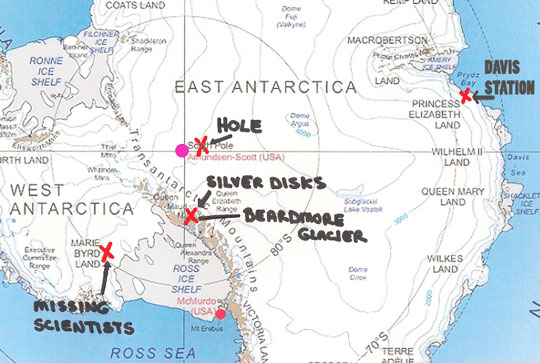
Locations identified by U. S. Naval Flight Engineer (Ret).
To: This email address is being protected from spambots. You need JavaScript enabled to view it.
Subject: Antarctica UFO
Date: January 2, 2015
Hi Linda
I am a retired United States Navy LC130 Flight Engineer that retired after 20 years of service in 1997. I have been wanting to write you for a long time about my experience on the Antarctic continent with flying vehicles that I was told not to talk about. I served part of my 20 years in the Navy with a Squadron called Antarctic Development Squadron Six or VXE-6 as it was also known. I served with this squadron from around 1983 till I retired March of 1997. Being a flight engineer and flying more then 4000 hours in that capacity I have seen things that most people have not even imagined on the Continent of Antarctica. The land there seems more alien then earthly. Our deployments to this land started in late September and ended the end of February every year until the Squadron was decommissioned in 1999. This time of year was the summer season when most of the science was done do to warmer temps and 24 hours of daylight.
During my time in the squadron I flew to almost every part of the Antarctic Continent including the South Pole more the 300 times. McMurdo Station which is 3.5 hours of flying time from the South Pole station was the point of squadron operation during our yearly deployments. Between these two stations is a mountain range called the Trans Antarctic's. With what we called Severe Clear weather from McMurdo to South Pole the Trans Antarctic's are visible from the altitudes which the aircraft flew approximately 25,000 to 35,000 feet. On several flights to and from South Pole our crew viewed air vehicles darting around the tops of Trans Antarctic's almost exactly in the same spot every time we would fly by and view them. This is very unusual for air traffic down there due to the fact that the only aircraft flying on the continent were our squadron aircraft. Every aircraft knew where the other aircraft were do to flight schedules being followed.
Another unique issue with South Pole station is that our aircraft was not allowed to fly over a certain area designated 5 miles from the station. The reason stated because of a air sampling camp in that area. This did not make any sense to any of us on the crew because on 2 different occasions we had to fly over this area. One time due to a medical evacuation of the Australian camp called Davis Camp. It was on the opposite side of the continent and we had to refuel at South Pole and a direct course to this Davis Camp was right over the air sampling station. The only thing we saw going over this camp was a very large hole going into the ice. You could fly one of our LC130 into this thing.
It was after this medevac mission we where briefed by some spooks (Intelligence Agents I presumed) from Washington DC and told not to speak of the area we overflew. The other time we got close to "The air sampling Camp" we had navigation and electrical failures on the aircraft and was told to immediately depart the area and report to our squadron commanding officer when we returned to McMurdo. Needless to say our pilot (Aircraft Commander) got his butt chewed and our crew was not on the South Pole supply run for over a month. There were many other times we saw things that was out of the ordinary.
One outlying camp (near Marie Byrd Land) we dropped scientists and their equipment at was out of communication with McMurdo for 2 weeks. Our crew flew back to the camp to find out if the scientists were ok. We found no one there and no sign of any fowl play. The Radio was working fine as we called McMurdo to verify it working properly. We left the camp and flew back to McMurdo as ordered by our CO. A week later the Scientist showed back up to there camp and called McMurdo for someone to come pick them up. Our crew got the flight back there to pick them since we put them into that camp and we knew the terrain and location. None of the scientists would talk to any of the crew on the plane and to me they looked scared.
As soon as we landed back at McMurdo they (Scientists) where put on another of our squadron aircraft and flown to Christchurch New Zealand. We never heard about them again. Their equipment that we brought back from the camp was put in quarantine and shipped back to the United States escorted by the same spooks that debriefed us about our fly over of the air sample camp/ large hole in the ice. I could go on and on about things and situations that I observed during my tour with VXE-6. Talk among the flight crews was that there is a UFO base at South Pole and some of the crew heard talk from some of the scientist working at the Pole of EBEs working with and interacting with the scientists at that air sampling camp/large ice hole.
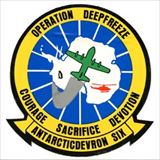
Insignia of Antarctic Development Squadron Six (VXE-6).
[ Editor's Note: Antarctic Development Squadron Six — VXE-6, or ANTARCTIC DEVRON SIX — was a United States Navy Air Test and Evaluation Squadron based at Naval Air Station Point Mugu, California, with forward operating bases at Christchurch, New Zealand and McMurdo Station, Antarctica. The squadron's mission was to provide aviation support for Operation Deep Freeze, the operational component of the United States Antarctic Program. ]
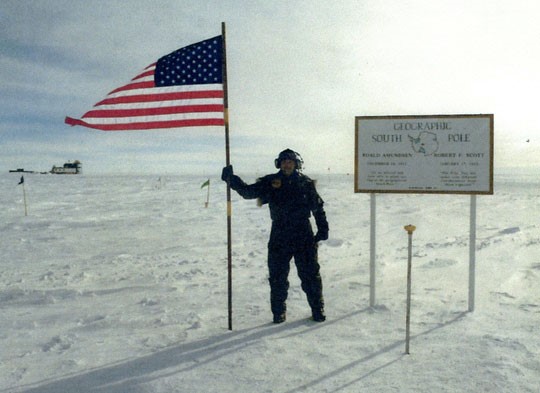
Brian holding U. S. flag next to the metal pole with yellow top that marked
the geographic south pole. Image courtesy Brian.
Brian, now 59, graduated from an Iowa college with an associate's degree in aviation maintenance technology and an aviation certificate. In 1977, he enlisted in the U. S. Navy and served for twenty years until his retirement in 1997. He provided Earthfiles his DD-214 documents and other certificates of service including this Antarctic Service Medal given to him on November 20, 1984.
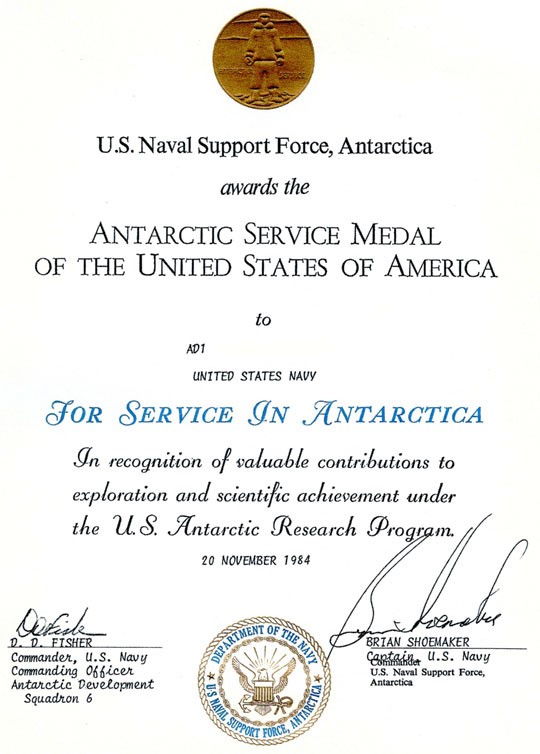
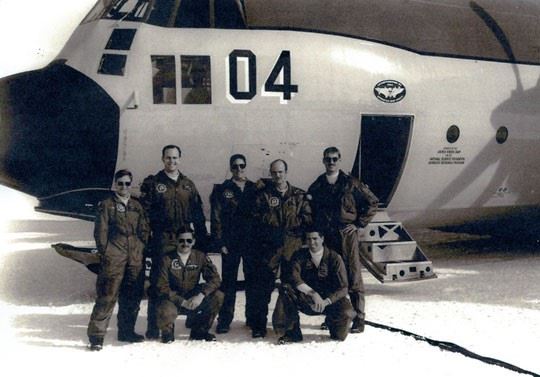
A Lockheed LC-130F Hercules ski-equipped Hercules of VXE-6 at the
Amundsen–Scott South Pole Station. Image courtesy Brian.
One sunny day in December 1995, Brian and his C-130 flight crew were on a mission from McMurdo Station to the South Pole. They were flying over the Transantarctic Mountains near Beardmore Glacier when they all saw shiny discs darting rapidly and stopping repeatedly around the mountain peaks, but never going over the glacier itself.
________________________________________
Interview:
Brian, 59, retired U. S. Navy Petty Officer First Class Flight Engineer, describing high strangeness events primarily in the 1995 to 1996 time period: “We were only about 10,000 feet above those mountains tops and all we could see on the initial sighting was the shiny reflection in the silvery things darting around down there.
I remember turning to my aircraft commander and pilot and saying, 'What are those things down there?'
He got on the intercom and said, 'Well, they are not ours — that's all I can tell you.'
WHAT WERE YOU SEEING IN TERMS OF SHAPE AND MOVEMENT?
The movement was very — I don't want to say jerky, but sporadic. The shiny objects, which I would say from our altitude looked circular and they would sprint to maybe three or four mountain tops. Then they would stop. Then maybe one or two would come up and meet it and then they would start off in another direction. It was always over the Transantarctic Mountain range. They never went over the Beardmore Glacier either.
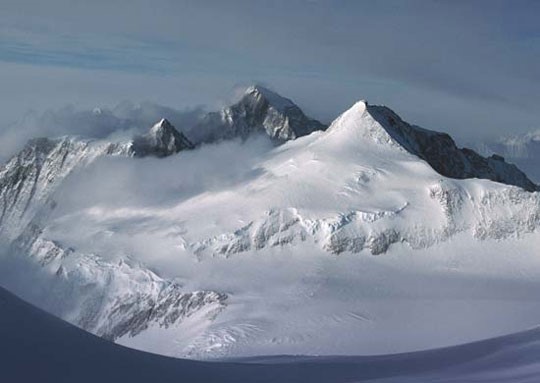
The Transantarctic Mountains are one of the longest mountain chains in the world
extending for 3,000 miles from Coats Land to the Ross Sea where the U. S. McMurdo Station
and Victoria Land are on the Ross Sea. Image by USGS.
\
The Beardmore Glacier in Antarctica, one of the largest valley glaciers in the world
at 125 miles long and 25 miles wide, was not far from where Brian and his Naval Flight
crew repeatedly saw round, silver discs dart around in the Transantarctic Mountain peaks,
but never over the Beardmore Glacier and not toward their C-130. Image by USGS.
DID ANY ONE OF THEM EVER APPROACH YOUR PLANE?
No, they were always below us, always stayed below us. We were told not to talk among ourselves other than just the crew. And just seeing those things down there, and being told that those aren't our aircraft, is kind of mind blowing, while the fact is, 'Hey, what are these things? Why doesn't anybody else know about this?'
Huge Hole in Ice Near South Pole -
An E.T. and Human Lab Collaboration?
We had a mission we had to do at an Australian camp called Davis Camp. In order to get there, we had to fly to South Pole to re-fuel our aircraft and then from there, we could fly all the way out to Davis Camp. We were told that we needed to get an airplane out there, a rescue medevac (medical evacuation) because one of the workers there had been burned badly in a boiler fire. So we were trying to get there as fast as we could. We're talking a six hour flight — 3.5 hours to South Pole and then another three hours from South Pole to Davis Camp.

The No Fly Zone's big hole (red X Hole) in the ice was only about 5-10 miles from the
geographic South Pole (pink circle at crosshairs). Three more hours by air beyond the
South Pole is the Australian Davis Station.
Davis is the most southerly Australian Antarctic station and is situated 2250 nautical miles south-south-west of Perth, on the Ingrid Christensen Coast of Princess Elizabeth Land. Davis Camp is 6 hours by air from the South Pole. There's an area on the opposite side of South Pole that was a No Fly Zone. That No Fly Zone, we were told, was an air sampling station that we couldn't fly over because it would contaminate their air sampling with our jet exhaust, which is kind of ridiculous because we fly kind of high! (laughs) If you are air sampling, you're air sampling at the ground.
Anyway, we were on our way over to that medevac and so we basically did a straight line. And when we got about five to ten miles from South Pole on the way to Davis Camp, we were told on the radio not to continue our straight line course, but to deviate a certain amount. Somebody mentioned, 'Hey, there's an air sampling system somewhere out here somewhere, you know?'
We looked down and here's this huge, large hole in the ice, almost like a cave entrance, but it was large enough that you could fly a C-130 into it, a hole that went down. We were told not to fly that area.
We continued our mission and picked up our medical emergency and turned around and came back and had to come back to South Pole to re-fuel, and when we got close to that air sampling again, we were told to deviate this way so many miles and then turn back on course. So we got fuel at South Pole, made our way back to McMurdo, landed and the entire crew was told to report to the Skipper's office.
We all got sat in this room and this guy came in that nobody had seen before. The only way I can describe him is kind of an intelligence-gathering type of an individual. We were sat down and he said, 'OK, you guys saw this thing. But you did not see it.'
AND HE MEANS THE BIG, DEEP HOLE? Yeah, the big hole in the ice that supposedly was the air sampling station. We were told to not talk about it — ever! And that area was considered off limits for research. IN YOUR EMAIL TO ME, YOU WROTE TOWARD THE END, 'TALK AMONG THE FLIGHT CREWS WAS THAT THERE IS A UFO BASE AT THE SOUTH POLE AND SOME OF THE CREW HEARD TALK FROM SOME OF THE SCIENTISTS WORKING AT THE POLE OF 'EBES,' AN ACRONYM FOR EXTRATERRESTRIAL BIOLOGICAL ENTITIES WORKING WITH THE SCIENTISTS AT THEIR AIR SAMPLING CAMP — WHICH IS THE LARGE HOLE IN THE ICE.'
Yeah, yeah, it's funny, you know, because we are told not to talk among ourselves officially. But the guys after a flight, they go to a club and, you know, you have a few beers and you're talking and it's like, 'I heard these scientists talking about that there's some guys there at South Pole that were working with these strange-looking 'men.' Of course, they put it that way so they weren't saying, you know, 'alien' or 'extraterrestrial,' or whatever. And that the air sampling station was actually a joint base with the scientists and the E.T.s that were working out of there (big hole in ice).
ANYTHING ABOUT WHAT WAS ACTUALLY GOING ON DOWN IN THAT BIG HOLE IN THE ICE?
All the talk that was heard between the scientists was being overheard by one of the flight crew that was there, the guy saying, 'Hey, two guys were talking in there and they were talking about these scientists that are going out to the air sampling area again to do their meet up with these E.T.s that were there.'
Missing Scientists At Camp in Marie Byrd Land
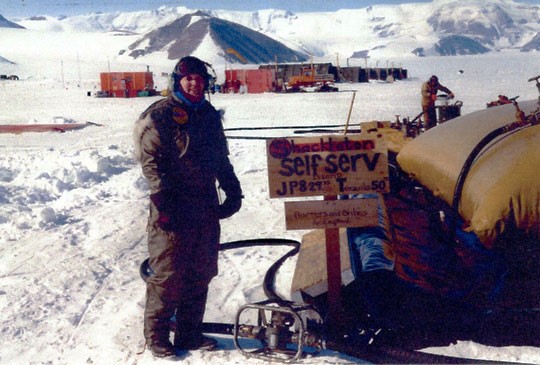
"This is the camp in Marie Byrd Land where all the scientists went missing for two weeks.
And when we finally picked them up again, "their faces looked scared." Image courtesy Brian.
IN YOUR EMAIL TO ME, YOU SAID, 'NONE OF THE SCIENTISTS WOULD TALK TO ANY OF THE CREW ON THE PLANE AND THEY LOOKED SCARED.'
That was a mission that concerned a camp that we had put in out on a plateau. It was probably a 2.5 hour trip from McMurdo and it was out in the middle of nowhere. We put this crew out there and dropped them off with all this science gear. It was that team that we set out there that McMurdo had lost communication with. They (McMurdo) hadn't heard anything from those guys — it must have been a week or two weeks. You're supposed to check in every so often by radio to tell McMurdo that everything is OK. You can't just pick up a landline, so you have to do all radio communication.
So after those two weeks when they (scientists) had not been heard of, we got sent back out there to see where they were. Well, when we got out there, there's nobody around. All the equipment was still there. There were some snow mobiles there. But the entire camp (of scientists) was gone.
We called McMurdo on their (camp's) radio to make sure that the radio was working and we could hear McMurdo fine. When we took off from there to go back to McMurdo, we kind of did a 15-mile circle around that camp to see if we could see them from the air or see any signs of any trails or anything going off. We didn't see anything! So we go back to McMurdo.
A week later, supposedly these scientists had gotten back to camp and they got on the radio and said, 'Hey, we're back here and want to be picked up.' And we went back in there, loaded up all their stuff, put them in the aircraft. We got the scientists in there and they all got set down in the back. Being the engineer on the airplane after we got airborn and stable, I went back looking around. And the looks fon these people's faces was just (laughs) — they looked scared is what they looked.
And I asked my load master, 'Where have these guys been?' And he said, 'I don't know. I can't get any words out of them. They just kind of sit there.' A couple of them, he said, he had like blank stares. He offered them food and stuff and nobody would take anything.
So, we get back to McMurdo and unload their gear. Passengers always have a separate ride to where the National Science Foundation chalet is and all the science support areas and all that. And their camp cargo, we were told to put it on this big sledge and then this tractor would pull it back up to McMurdo. Then their camp equipment was put in a separate building and nobody was allowed in there. So, basically it was put in isolation. 'OK, this is kind of weird. Why is that stuff being isolated?'
Must have been probably a week later that we found out, with everybody talking in the camp — all the civilians because all the scientists were civilians and a lot of support people there, civilian. The military, there was our squadron. They (civilians) were all talking and you could hear people, 'Yeah, those guys went back to Christchurch (New Zealand).
[Editor's Note: Christchurch is the largest city in the South Island of New Zealand, and the country's third-most populous urban area. It lies one third of the way down the South Island's east coast.]
Nobody said anything and all sorts of weird stuff going on. They even had a special flight for these guys (scared scientists). One of our aircraft — that's all that was on it was them. None of their gear. Just their luggage and their survival gear that everybody wears and they were taken back to Christchurch.
Well, all of their gear that squadron had put into storage isolation area all got put on another airplane all by itself — no other cargo — and it got flown back to Christchurch. And that was the last that we ever heard of that.
NO WORDS OUT OF THESE SCIENTISTS?
Not to my knowledge. I mean, our crew didn't hear anything.
HOW MANY WERE THERE?
At least ten, maybe fifteen (scared scientists).
WERE THEY ALL MALE?
No, there was at least one female, and maybe two.
AM I UNDERSTANDING CORRECTLY THAT EACH OF THE SCIENCE GROUPS THAT YOU GUYS FLEW IN AND OUT OF THE ANTARCTIC BASE, THEY KNEW THEY WERE GOING TO WORK WITH EXTRATERRESTRIAL BIOLOGICAL ENTITIES DOWN IN THAT BIG HOLE?
I'm sure it was all compartmentalized. There was only a certain select group of scientists that did that job and nobody else was privy to that information or going to that area. And what somebody had overheard was that there was an installation, a joint venture, at Pole, not necessarily at the South Pole station but in the vicinity of South Pole. They were conducting some kind of project.
BETWEEN EXTRATERRESTRIAL BIOLOGICAL ENTITIES AND THE HUMAN SCIENTISTS.
Correct. And everybody was speculating. It was like, 'Man, what did these guys see? Why were they gone for two weeks that nobody knew where they were?'
It was like, 'Man, these people are kind of freaked out about something.' They just wanted to get out of there.
AND THE FACT THAT THEY DISAPPEARED FOR TWO WEEKS.
Right. It was like, 'Are we going back out there in a couple of weeks to bring out dead bodies? Or what are we doing?' But it was hushed up pretty good.
It makes you wonder, like OK, so what is our government and other governments doing that we don't know about that's going on down there with visitors from somewhere else? And what possibly is still going on down there?”
